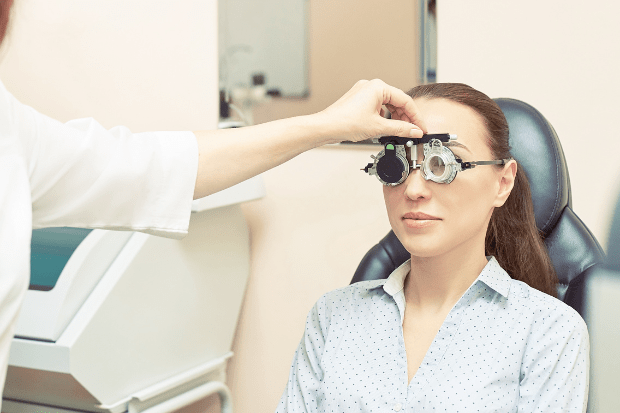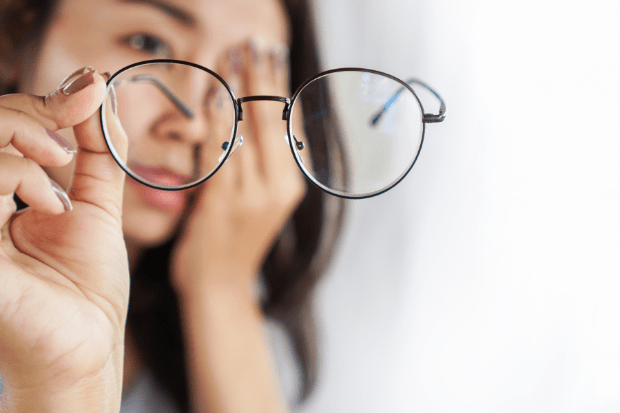How bad is my eye prescription

It is not as important to know how bad your eye prescription is but whether your vision can be fully corrected with your eyeglass prescription. Unless you have a type of eye disease or eye condition like a lazy eye, your glasses, and contact lenses prescriptions are written to give you 20/20 vision. Cataracts, macular degeneration, diseases of the retina, amblyopia, or strabismus may prevent you from attaining 20/20 vision even with your glasses on.
How Do I Read a Glasses Prescription?
A glasses prescription is divided into three parts: sphere, astigmatism, and axis. You may or may not have all three parts. The numbers indicate the amount of astigmatism you have or how near or far-sighted you are. Those over 40 years of age may also have a fourth component called an add. An add refers to your reading power. Though rare, some glasses prescriptions may include prisms to align your eye muscles. For more information on how to read your glasses prescription, visit our guide.
How Strong Is My Eye Prescription?
The closer your prescription value is to zero, the milder your prescription is. A (+) sign indicates you see good to okay in the distance but need your glasses for reading. A (-) prescription indicates you need your glasses to see in the distance. Your prescription is measured in a unit called a diopter (D). The American Optometric Association (AOA) has determined several levels of eye prescription severity.
For near-sightedness (myopia):
- If your number is between -0.25 and -2.00, you have mild nearsightedness.
- If your number is between -2.25 and -5.00, you have moderate nearsightedness.
- If your number is greater than -5.00, you have high nearsightedness.
For far-sightedness (hyperopia):
- If your number is between +0.25 and +2.00, you have mild farsightedness.
- If your number is between +2.25 and +5.00, you have moderate farsightedness.
- If your number is greater than +5.00, you have high farsightedness.
Will my vision get worse?
Your vision is a combination of both your genetics and environmental factors. If your parents wear glasses, you have a significantly higher risk of needing glasses. If your parents have a high glasses prescription, often you will also. While you cannot change your genetics, you have some control over environmental factors. If you are a significant reader, your vision may often get worse during different parts of your life. Education level, occupation, digital device use, a healthy diet, UV protection, and exercise affect whether our vision worsens. Genetic and environmental factors are unique for each of us.
How Eyesight Changes
While eyesight can change throughout life, vision usually changes at two key points. Most often, many begin wearing glasses in their childhood, pre-teen, or teenage years. In this age patient age group, vision worsens with reading, studying, and digital device use and with growth spurts. Even those who are lucky never to wear glasses as children or adolescents will need glasses when they turn 40 years old. A condition called presbyopia affects the lens and the eye’s focusing ability and worsens one’s near vision. Patients will begin to need reading glasses, and their vision will worsen yearly until 62 or so. The added prescription in their glasses will need to be increased every couple of years. Furthermore, as you age, eye problems like cataracts, glaucoma, and macular degeneration will likely affect your vision. Maintaining a healthy lifestyle, not smoking, and wearing sunglasses with UV protection can decrease your risk of developing an eye disease.

What Eye Prescription is Legally Blind?
Even if you have a severe eyeglass prescription, you are not considered legally blind. "Legal blindness" is a definition used by the United States government to determine one’s eligibility for special training, rehabilitation, school, disability benefits, low vision devices, and tax exemption programs. The term is vague as to what one can and cannot see. The U.S. government has two parts to its description of legal blindness: vision acuity and visual field. A patient only needs to meet one of the two criteria. Visual Acuity: A visual acuity of 20/200 or less in the better-seeing eye with the best conventional correction (with regular glasses or contact lenses). This is measured using the Snellen Eye Chart. If you can only read the big “E” at 20 feet while wearing your regular glasses, you are considered legally blind. Visual Field: A visual field of 20 degrees or less (called tunnel vision) in the better-seeing eye. This is measured using a perimeter or visual field machine. Your visual field refers to the total area you can see without moving your eyes from side to side. Low Vision is a term that describes uncorrectable vision loss that interferes with one’s daily activities. Many low-vision devices and therapies can help someone with vision loss regain their independence. Low-vision doctors are usually optometrists trained specifically to help low-vision patients.
What is a 20/20 vision?
20/20 vision is used to describe normal visual acuity (clarity or sharpness) measured at 20 feet. 20/20 vision is determined using a Snellen acuity chart. If you are told you have 20/20 vision, you can see clearly at 20 feet what should normally be seen at 20 feet. If you have 20/200 vision, it means that you must be as close as 20 feet to see what a person with normal vision can see at 200 feet. Someone with 20/20 vision has a prescription closer to zero, whereas someone with 20/200 vision has a prescription around -2.00D. Even if you have a 20/20 vision, you may not have perfect vision. You may have a little bit of astigmatism, a small hyperopia prescription, or require reading glasses. 20/20 vision only indicates the sharpness or clarity of vision in the distance. Eye doctors also evaluate other vision skills, including peripheral vision, eye coordination or eye teaming, depth perception, focusing ability (accommodation), and color vision. If you do not have 20/20 vision, you may need eyeglasses, contact lenses, prism, vision therapy, or other types of treatment to improve your vision.
How often should you get your eyes checked?
Even if you have 20/20 vision, getting your eyes checked annually is important. An eye exam is not just about how you see but the health of the eye. It is possible to have 20/20 vision and undiagnosed eye diseases. Many systemic health problems like diabetes and hypertension can result in vision loss over time.
Conclusion
Those of us who wear glasses often worry about our prescriptions getting worse, but the most important thing to remember is that our vision can be corrected to 20/20 with our eyeglass prescription. Annual eye exams are vital to ensure we are seeing our best and our eyes are healthy and free of any eye diseases.
